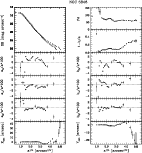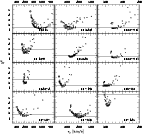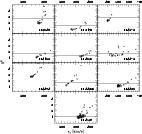

Up: Orbital structure and mass
Subsections
3 Photometry and distances
Table 3 gives characteristic photometric quantities and
distances for all galaxies in our combined sample. Since the
luminosity distribution is needed to calculate the mass-to-light
ratio, we check the calibration of the adopted surface brightness
profiles as follows. We take photoelectric aperture measurements of
Burstein et al. ([1987]), correct them for extinction and
convert to the distances listed in Table 3. The resulting
aperture magnitudes are compared to the values obtained by integrating
our (CCD-) SB profiles (converted to B-band when necessary) out to
the radius of the aperture. Only two galaxies appear not correctly
calibrated: NGC 1399 and NGC 7507. For these two cases we correct the
final mass-to-light ratios to the aperture magnitude system given by
Burstein et al. ([1987]).
Table 3:
Photometry and distances for all galaxies in the sample.
Column 1 gives the NGC number, Col. 2 the morphological type, Col. 3
the adopted distance, Col. 4 the total integrated magnitude as
given in the RC3 (de Vaucouleurs et al. [1991]), Col. 5 the
effective radius in arcsec, Col. 6 the source of the effective radius
(b Bicknell [1989], bs BSG94, f Faber et al. [1989], g Gerhard
et al. [1998], p Peletier et al. [1990], r Rix et al.
[1997]), Col. 7 the photometric band, Col. 8
the source of the photometric data: Be is Bender (unpublished), B
Bicknell et al. ([1989]), C90 Caon et al. ([1990]), C94
Caon et al. ([1994]), C Carollo et al. ([1994],
[1997]), Da Davis et al. ([1985]), D Djorgovski
([1985]), GS Gerhard & Saglia (Sect. 3.5), G98
Gerhard et al. ([1998]), G Goudfrooij et al. ([1994]), J
Jørgensen et al. ([1995]), Ke Kent ([1984]), K King
([1978]), L Lauer et al. ([1995]), LV Lauberts &
Valentijn ([1989]), M Michard ([1985]), P Peletier et al.
([1990]), P97 Prugniel ([1997]). Where two author
abbreviations are given separated by a comma, the first is for ground
based and the second for HST data. Author abbreviations separated by a
"+'' signify that their data were merged. Columns 9 and 10 are the inner
and outer boundaries of the photometry in units of the effective
radius, Cols. 11 and 12 similarly for the kinematic data. In case of
NGC 3379 S denotes the data from Statler & Smecker-Hane
([1999])
| NGC |
type |
d[Mpc] |
 |
 ['']
[''] |
Source |
Band |
Source |
![$R_{\rm min}^{\rm phot} [R_{\rm e}]$](/articles/aas/full/2000/10/ds9521/img38.gif) |
![$R_{\rm max}^{\rm phot} [R_{\rm e}]$](/articles/aas/full/2000/10/ds9521/img39.gif) |
![$R_{\rm min}^{\rm kin} [R_{\rm e}]$](/articles/aas/full/2000/10/ds9521/img40.gif) |
![$R_{\rm max}^{\rm kin} [R_{\rm e}]$](/articles/aas/full/2000/10/ds9521/img41.gif) |
| |
|
|
|
|
|
|
|
|
|
|
|
| 315 |
E2,cD |
77.6 |
-22.25 |
68 |
p |
B |
P |
0.056 |
1.4 |
0.002 |
1.13 |
| 1399 |
E1,cD |
21.9 |
-21.15 |
42 |
b |
B |
B,L |
0.0010 |
75.3 |
0.002 |
2.31 |
| 2434 |
E0-1 |
30.3 |
-20.08 |
24 |
r |
B, V |
C,C |
0.0006 |
6.3 |
0.006 |
2.58 |
| 3379 |
E1 |
13.2 |
-20.36 |
35 |
f |
B, R |
Da |
0.04 |
4.5 |
0.005 |
2.95 |
| S |
|
|
|
|
|
|
|
|
|
0.0 |
2.23 |
| 4374 |
E1 |
20.5 |
-21.47 |
57 |
p |
B |
M |
0.009 |
7.8 |
0.005 |
1.17 |
| 5846 |
E0 |
35.9 |
-21.73 |
83 |
f |
V |
GS |
0.0 |
6.7 |
0.004 |
1.19 |
| 6703 |
E0 |
28.0 |
-19.92 |
30 |
g |
B |
G98 |
0.003 |
2.4 |
0.006 |
2.61 |
| 7145 |
E0 |
28.4 |
-20.23 |
39 |
f |
B |
J |
0.003 |
2.8 |
0.007 |
1.66 |
| 7192 |
E0 |
37.0 |
-20.65 |
34 |
f |
R |
C,C |
0.0004 |
5.9 |
0.0006 |
0.75 |
| 7507 |
E0 |
26.9 |
-20.79 |
31 |
f |
B |
Be+LV |
0.009 |
4.1 |
0.005 |
1.66 |
| 7626 |
E1 pec |
55.1 |
-21.55 |
38 |
f |
B |
K+P,Be |
0.0003 |
1.8 |
0.003 |
2.10 |
| 3193 |
E2 |
37.8 |
-21.06 |
24 |
bs |
B |
G |
0.04 |
2.7 |
0.03 |
1.41 |
| 3640 |
E2 |
35.1 |
-21.37 |
33 |
bs |
B |
G |
0.03 |
2.8 |
0.02 |
0.63 |
| 4168 |
E1 |
41.8 |
-21.00 |
45 |
bs |
B |
C90 |
0.005 |
5.4 |
0.01 |
0.67 |
| 4278 |
E1 |
22.6 |
-20.68 |
33 |
bs |
B |
G |
0.03 |
2.9 |
0.02 |
0.45 |
| 4472 |
E1 |
20.5 |
-22.19 |
104 |
bs |
B |
C94 |
0.006 |
12.5 |
0.005 |
0.54 |
| 4486 |
E0 |
20.5 |
-21.97 |
110 |
p |
B |
C90 |
0.003 |
8.9 |
0.02 |
0.39 |
| 4486B |
cE1 |
20.5 |
-17.20 |
3.1 |
bs |
V |
P97,L |
0.007 |
6.5 |
0.2 |
2.79 |
| 4494 |
E1 |
10.7 |
-19.44 |
45 |
bs |
B |
G |
0.02 |
1.8 |
0.01 |
0.71 |
| 4589 |
E2 |
46.6 |
-21.65 |
41 |
bs |
B |
G |
0.03 |
2.2 |
0.02 |
0.77 |
| 4636 |
E0 |
20.5 |
-21.13 |
102 |
bs |
B |
C94,L |
0.0001 |
6.4 |
0.02 |
0.33 |
Distances to elliptical galaxies are still uncertain and the scatter
between the values based on different methods is considerable.
Therefore, we have adopted the uniform set of group distances based on the
Dn-sigma distance estimator from Faber et al. ([1989]; Col. R
of their Table 3), converting to Mpc with a
Hubble constant of H0 = 65 km s-1/Mpc. All M/L values listed below
and shown in Figs. 20 and 21 are transformed to these
"standard distances'' given in Table 3.
The SB-profile of Peletier et al. ([1990]) extends from 3.8
arcsec out to 91.8 arcsec. Since the kinematic data range further
inwards than the photometric data the SB-profile was extrapolated
using a power-law; the fitted slope is -1.01. This might overestimate
the actual luminosity in the central regions since one might expect
the cD galaxy NGC 315 to have a core with a shallower slope. Due to
the outer cutoff of the SB-profile at R = 91.8 arcsec, the total
luminosity is an underestimate because the slope of the density
profile at the cutoff of the data is still larger than -3. This must
then also be true for the  value from the RC3.
value from the RC3.
The SB-profile is composite of V-band HST-data from Carollo et al.
([1997]) out to 10 arcsec and B-band ground-based data by
Carollo & Danziger ([1994]). The HST data were shifted by 0.88
mag to give a smooth transition between the two data sets. Note that
Faber et al. ([1989]) give an effective radius of 81 arcsec
whereas Rix et al. ([1997]) took 24 arcsec. In our analysis we
used the latter value, but this is used only as a scaling constant and
has no influence on any of the derived quantities.
For this galaxy we used the CCD surface photometry of Davis et al.
([1985]) in both the R- and B-bands.
We used the photometry of Michard ([1985]). The innermost data point was
removed.
The V band surface brightness profile of NGC 5846 was derived from
observations performed in March 1999 at the ESO 2.2 m telescope
equipped with the Wide Field Imager. This instrument covers a
 arcmin2 field of view with a mosaic of
arcmin2 field of view with a mosaic of  CCDs
of 2K
CCDs
of 2K  4K 15
4K 15  m pixels, with a scale of 0.238 arcsec/pixel.
Six 5 minutes exposures were taken, shifted by 20 arcsecs in RA and Dec
to fill the gaps between the CCDs. The reduction of the frames was
performed under IRAF, using the mscred package to handle mosaic
data. After the bias subtraction, sky flat-fielding, and frame
combination (performed after the astrometric calibration) the
resulting image is flat at the 1% level.
m pixels, with a scale of 0.238 arcsec/pixel.
Six 5 minutes exposures were taken, shifted by 20 arcsecs in RA and Dec
to fill the gaps between the CCDs. The reduction of the frames was
performed under IRAF, using the mscred package to handle mosaic
data. After the bias subtraction, sky flat-fielding, and frame
combination (performed after the astrometric calibration) the
resulting image is flat at the 1% level.
The isophote shape analysis was performed following Bender & Möllenhoff ([1987]). The procedure was improved in two aspects. Mask
files were produced automatically from the "segmentation frames''
produced by the Sextractor program (Bertin & Arnouts [1996]). The
surface brightness and integrated magnitude profiles following
elliptical isophotes were computed from the averages of the unmasked
pixels between the isophotes. Statistical errors were also derived
from the measured rms. Radial profiles of surface brightness,
ellipticity, position angle and higher order terms of the Fourier
analysis are shown in Fig. 9. Note that the centers of
the outer isophotes (at more than 500 arcsec from the center) are some
30 arcsec off the center of the inner ones. The surface brightness has
been calibrated using the V-band photoelectric photometry of Colless et al.
([1993]). The comparison with data of Bender (unpublished) obtained with
a small field of view CCD show good agreement up to 40 arcsec from the
center, where the sky subtraction of Bender's data becomes unreliable.
 |
Figure 9:
The V-band surface brightness and isophote shape parameters of NGC 5846 as
a function of the 1/4 power of the semimajor distance from the center |
The SB-profile of Jørgensen et al. ([1995]) was used; the last two data
points seem to suffer from sky subtraction errors and were dropped.
For NGC 7192 HST photometry from Carollo et al. ([1997]) is available.
These V-band data were shifted by -0.47 mag to merge smoothly into the
ground-based R-band data from Carollo & Danziger ([1994]).
The HST-data were used out to 10.9 arcsec.
The SB-profile is a composite of data from Bender (unpublished)
and from Lauberts & Valentijn ([1989]). The outermost data point
was not used since it might be affected by sky-subtraction errors.
Because the kinematic data reach further in towards the center than
the photometry, we extrapolated using a power-law. The fitted central
slope of the SB-profile is -0.15.
B-band ground-based data from King ([1978]) and Peletier et al. ([1990]) were merged
with V-band HST-data (Bender, unpublished), after shifting the HST-data
by -0.6 mag.
The SB-profile was taken from the electronically available tables of
Goudfrooij et al. ([1994]). The profile was slightly oversmoothed to
avoid high frequency fluctuations in the density profile.
 |
Figure 10:
 versus circular velocity. Horizontal
lines indicate the (rescaled)
versus circular velocity. Horizontal
lines indicate the (rescaled)  confidence levels. Models lying
above that line are inconsistent with the kinematic data. The SC
models are encircled. For NGC 7145 it lies outside the plot. Note that
the scale of the
confidence levels. Models lying
above that line are inconsistent with the kinematic data. The SC
models are encircled. For NGC 7145 it lies outside the plot. Note that
the scale of the
 axes is different for each column
axes is different for each column |
 |
Figure 11:
 versus circular velocity for the
galaxies with kinematics from BSG94. Horizontal lines indicate the
(rescaled)
versus circular velocity for the
galaxies with kinematics from BSG94. Horizontal lines indicate the
(rescaled)  confidence levels. Models lying above that line are
inconsistent with the kinematic data. The SC models are encircled
confidence levels. Models lying above that line are
inconsistent with the kinematic data. The SC models are encircled |
For this E2 galaxy the photometric data are from Goudfrooij et al.
([1994]). The data were extrapolated towards the center using a
power-law to match the extent of the kinematic data; the fitted
slope is -0.46.
We used photometric data of Caon et al. ([1990]) for this E1 galaxy.
The profile was slightly oversmoothed to ensure a monotonically decreasing
density profile.
For this galaxy we used the SB-profile of Goudfrooij et al. ([1994]);
this was oversmoothed compared to the GCV estimation (see Sect. 4) and
extrapolated towards the center; the fitted central slope is -0.50.
The total B-band magnitude of NGC 4472 and the effective radius
 arcsec are comparable to the corresponding
values for NGC 4486. The SB-data are taken from Caon et al. ([1994]).
arcsec are comparable to the corresponding
values for NGC 4486. The SB-data are taken from Caon et al. ([1994]).
We used the photometry of Caon et al. ([1990]). For the effective radius
we take the value of 110 arcsec given by Peletier et al. ([1990]).
NGC 4486B is a close companion of M 87 and is in some respects
comparable to M 32, the compact companion of M 31. There is an HST
SB-profile available from Lauer et al. ([1995]) to which ground-based
data from Prugniel ([1997]) were added after shifting by 0.6 mag.
We used B-band photometry by Goudfrooij et al. ([1994]) for this E1
galaxy. The profile was extrapolated towards the center employing a
power-law; the fitted slope is -0.57.
We used photometry by from Goudfrooij et al. ([1994]) and extrapolated
the profile towards the center; the fitted slope is -0.50.
HST-photometry by Lauer et al. ([1995]) and ground-based data
by Caon et al. ([1994]) were merged. The HST-V-band data were
shifted by 1 mag to provide a smooth transition.


Up: Orbital structure and mass
Copyright The European Southern Observatory (ESO)


